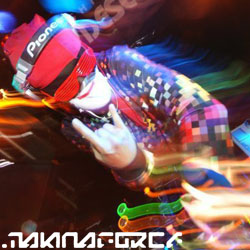Interview: M-Project – The Pantyhose Makina Junkie
 M-Project has participated in all of Makinaforce’s releases and has been widely recognized as Japan’s top makina artist. Always wearing pantyhose as his identity, he has been in the scene for 10 or more years now and is still pursuing his goals in makina. His Underground Makina Connectionz is a successful compilation series bringing the best from Spain to Japan as well as worldwide attention. Makinaforce is proud to bring you an interview with M-Project!
M-Project has participated in all of Makinaforce’s releases and has been widely recognized as Japan’s top makina artist. Always wearing pantyhose as his identity, he has been in the scene for 10 or more years now and is still pursuing his goals in makina. His Underground Makina Connectionz is a successful compilation series bringing the best from Spain to Japan as well as worldwide attention. Makinaforce is proud to bring you an interview with M-Project!
Makinacast 2 – M-Project
I’m sure it is fairly obvious to what “M-Project” stands for but could you tell us something more about the name?
In society, there are things that are useful to know and things that are not so useful to know. I believe that knowing where and how I got the name is not very important. However, one thing I can say is that the M in M-Project does not stand for Music.
Being in Japan how did you discover the harder sounds of electronic music? And furthermore makina?
A lot of European Dance Music was already in Japan so it was only a matter of time until I came across makina. In the year 1999 or 2000, while UK Hardcore was declining, I was digging for a hardcore record that was released around that time and had my first encounter with makina. During this time, UK Hardcore was in its transformation period of mixing trance together and that didn’t feel right to me. So discovering makina was a very big event for me.
How is makina perceived in Japan?
Japanese people are very sensitive to melodies, so I think they tend to prefer a genre like makina, which consists of powerful melodies, rather than a genre that has little to no melody.
Did you have any idea about how makina would do in Japan? Any doubts or expectations you had when you started this project?
I didn’t think I would be continuing this for over 10 years, but the dream that I had for 10 years has been coming true recently, I am very happy. Especially being able to release the remix I did of “Melody of Passion II” was very inspiring. The makina scene to exist in Japan is without a doubt. In the recent years, listeners of makina has multiplied like a sudden explosion and I am very happy about the progression. Although I believe there is still more potential that we have not reached yet.
From the time you started creating makina, has there been anyone else in Japan creating makina that has caught your attention?
I was the first makina producer in Japan so when I started there was no one else but me.
How did you get started in producing music? What kind of equipment did you start out with and what do you use currently?
When I first started I was using Reason’s Propellerhead but I felt that the software was at its limit for me. So I switched over to Steinberg’s Cubase series. Cubase allowed me to go into more detail in my productions but it also took me a long time to understand it. Right now I am using Cubase 4 and I plan to update my studio equipment as well as update to Cubase 6.
What do you think about the current trend in makina? The hard-trance vs remember style makina.
I actually like hard-trance, so I personally enjoy it. However in makina, I feel that mixing too much hard-trance into it will lack uniqueness to a makina song.
You have been in the makina scene for a long time. There has been speculations about makina being a dyng genre. Where do you see makina going in the next few years? Do you think it is a dyng genre?
Makina releases are starting to slowly decline and when I first heard the rumours I started the Underground Makina Connectionz series. I wanted to stay active and keep makina moving because I didn’t want to wait for overseas releases. I believe that as long as somebody continues to produce makina, makina will never die.
You have played in America at Anime Central in Chicago and Anime Expo in Los Angeles. Being probably the first makina artist to play in America, how is the crowd reaction in America? Currently UK Hardcore seems to be the popular style in America within this genre.
I have been performing at Anime Central in Chicago since 2007 and it has been getting better each year. At Anime Expo, the venue was Club Nokia so the sound system, booth, and equipment was perfect. And of course the crowd was also very responsive. I am very happy that so many fans came to both events and I’m very grateful for that.
During your performances you always wear a type of costume which is made up of multiple pantyhoses and a surgical mask. When you first started it was only one black pantyhose and now it has evolved into a whole variety of colors, a surgical mask, and shutter shades. How did this come about and evolve over time?
In society, there are things that are useful to know and things that are not so useful to know. I believe that knowing how I came up with the costume is not important. However, one thing I can say is that it’s hard to breathe while wearing the costume.
In many of your productions and live performances, you are often seen to be collaborating with DJ Depath. How did you two first meet?
It has been over 10 years, so I don’t really remember.
What do you think of the makina scene in Spain?
There is an abundance of information about makina on the net but it is mostly in Spanish so not all of the culture is being understood correctly. So for that point, I think Makinaforce’s website is making a big contribution to the scene.
How did the event of X-Treme Hard with Jordi K-Staña of NOx Records come about? Jordi being the first Spain makina artist to perform overseas, how was the event?
Lots of “makina freaks” were excited about the event since Jordi was the first Spanish makina artist to visit Japan. Also, Japan was able to expierence for the first time, Jordi’s DJ set was performed like how they perform in Spain clubs, which is BCN style.
Did you get the chance to meet K-rlos DJ, Dani Delirio, and Ales? I believe they were in Japan the month after.
I met them for just a moment, so I didn’t really get the chance to talk to them.
Do you feel that the people in Japan take makina differently than the people in Spain?
There definitely is a difference in culture. Neither DJ Depath nor I mix BCN style during performances. Although I feel that in Japan people want to listen to each song one by one, more in depth.
You also produce other styles of music other than makina under the name “M-Project”, why is that?
In society, there are things that are useful to know and things that are not so useful to know. I believe that knowing this is not very important. However, if I were to say one thing it would be that I may not be thinking about anything in particular.
When will you show us your face?
As of now there is no plan to reveal my identity but there are a few that already know it but I will not officially show myself.
Thank you for your time in doing this interview. Any last words?
I appreciate all the support that I receive from everyone. I will continue to give it my all.
Interpreted by Miharu Hayashi







